
10/22/12 Its pouring rain outside with 1.5" after only 8 hours. We are very happy to have all the fruit in.
James and I are working on invoicing today. Below is a summary of the fruit that came out of Konrad Vineyards and the corresponding yield numbers. The yield which averaged 2.3 tons/acre is below our target which is 2.6-2.9 tons/acre but, the fruit quality was excellent.
| Owner/Blocks | Acres | Tonnage T | Yield tons/acre |
| Fontanella K1 | 0.76 | 1.816 | 2.4 |
| Fontanella K3U,K4U | 1.62 | 3.022 | 1.9 |
| Hunter K2U | 0.56 | 0.988 | 1.8 |
| Sherman K1 | 0.24 | 0.549 | 2.3 |
| Sherman K2U | 0.15 | 0.507 | 3.4 |
| Sherman K4L | 0.67 | 1.62 | 2.4 |
| Johnson K2L | 0.81 | 2 | 2.5 |
| Tate K3L | 0.54 | 1.254 | 2.3 |
| Ames K5 | 1.43 | 2.4785 | 1.7 |
| Valenti K6 | 1.2 | 4.263 | 3.6 |
| Konrad K2U | 0.1 | 0.473 | 4.7 |
| totals | 8.08 | 18.9705 | Avg. 2.3 |
10/20/12 We harvested the last of the fruit at Camalie, 4.2 tons from the North sides of the vines today.
10/12/12 There is a big gap here because my Son, Cameron went into the hospital for open heart surgery. I am pleased to report that all went well. My sincere thanks to Ramon and Dr. Konrad and to all of the buyers for picking up my responsibilities during this period and carrying through the harvest without me.
10/3/12 The heat wave should be over. Here are the temps minute by minute over the last week. You can see that Camalie peak temps are about 5F higher at their peak than Konrad K1 and quite a bit cooler at night as well. Camalie got up to 101F twice and Konrad 96F twice. I haven't been able to get to the vineyard so I don't know the state of the fruit but, I don't expect it to be too bad since we have good soil moisture yet. We normally get a couple days of 100F weather a year.

10/1/12 Dr. Konrad took some samples from his vineyard and measured Brix. See the table below. Note the sampling locations are different from my usual locations. I am out of the loop for the time being with a family medical emergency. Do call Ramon at 707-246-2297 or Dr. Konrad at 707-350-4105 to schedule your harvest. Our policy is first scheduled first served.
9/26/12 New Brix data for Camalie taken by Franciscan, Approximately 1 Brix up in a week which is expected.
9/25/12 Picked the Malbec, all 69lbs. of it. Very good fruit specs., 26Brix, 3.5pH,4.7 g/l T.A. and flavor for this first fruit from an April 2010 planting. Dr. Konrad vinified this fruit in my absence with some help from Jeff Fontanella and Ryan Sherman. The result is our first glimpse of what the Malbec can provide. The wine has a fruity nose of something similar to watermelon. This could be the fruity element we have been looking for to blend with the big Mt. Veeder cab foundation.
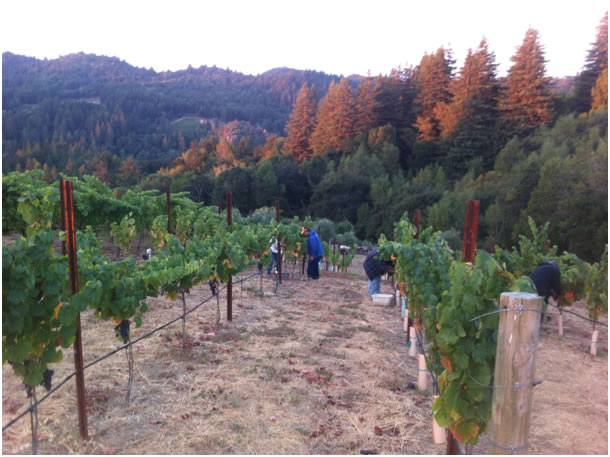
Rob Hunter came up and sampled K2U around 10:00am with the following results:
K2U East 25.0 Bx/ 6.23 TiA/ 3.61 pH
K2U West 25.1 Bx/ 7.35 TiA/ 3.51 pH
Rob's T.A.s seem high and disagree with the 3.6 that Ryan Sherman measured for the same block a day earlier. Rob's pHs are lower consistent with the higher T.A.s. The Brix agree. Small mystery here. Rob said he adds his juice to boiling distilled water before titrating to disolve any Potassium Bitartrate that may have precipitated in the grapes. This could explain the difference in T.A.s. If true one should be careful about acidifying preferment if your T.A. measurement doesn't include the boiling water step.
9/24/12 It's getting exciting now. There is a fair amount of fruit above 24 Brix already so if you haven't come out to check your blocks and schedule your harvest now is a good time. There is a heat wave expected later this week and peaking on the weekend which will likely cause dehydration and a sugar spike. The forecast thanks to Jeff Fontanella can be viewed at Napafcst092412.
Harvest Schedule as of 9/25/12:
| Buyer | Block | acres | tons | Yield | Harvest Day | Destination | boxes | scale
|
Notes |
|---|---|---|---|---|---|---|---|---|---|
| Holler | K-Malbec | .17 | 69 lbs. | NA | Tuesday 9/25 | Camalie Cave | 3 lugs | small scale | 26Brix, 3.5pH,4.7 g/l T.A. First Fruit from 2010 planting. |
| Marketta | C-Merlot | 0.17 | ~.75 | Friday 9/28 |
Combs St. Napa. | Camalie x 2 | Camalie small Scale | Haul in Pickup Truck and leave it there | |
| Sherman | K4L, K1x,K2Ux |
.67 + | ~2.8 | Saturday 9/29, K1x,K2Ux only, half ton each | Fields Family Winery Lodi. | Use 2 Camalie Boxes | Use Camalie scale. | Drive in Pick up truck, em pty on delivery and bring boxes back |
|
| Fontanella | K1,K3U, K4U | 2.6 - | ~6.7 | Fontanella Winery, Partrick Road. | Fontanella Winery | ||||
| Hunter3 | K2UE | .4 | ~1.1 | has scale | |||||
| Arbuckle | K5 | 1.4 | ~3.5 | ||||||
| Wood | C8 | .85 | 1.356 |
|
Will Pick up Fruit |
Use his 125 -5 gallon buckets | Has small scale. | Pick C8 from west end until all buckets full. | |
| Tate | K3L | .54 | ~1.4 | ||||||
| Franciscan | Camalie 90 | 3.5 | ~10 | has scale | |||||
| Johnson | K5 | 1.4 | ~3.8 | Fulton Road. | ? | ||||
| Valenti | K6 | 1.2 | ~3.5 |
I have included some rough estimates of tonnage based on a 2.7 ton/acre assumption. This should be within 10% of the real number in most cases. If you don't seen information in your table entry please e-mail to me soon especially delivery address, boxes you will provide and what scale you expect to use. Your help is appreciated.
9/23/12 Ryan Sherman took samples from Blocks K1 and K2U this morning at around 10:00am. He crushed them and cold soaked the juice overnight and then submitted them for lab analysis on 9/24/12. Thanks very much to Ryan for sharing these. Here are the results: Note the K2 sample was from K2U about mid block.
9/21/12 2:00pm I took a few Brix samples at Camalie. The most exciting was the merlot sample which came in at 25.7 Brix. You can see some significant dimpling too. Flavors are great. I went back out and took four samples from Konrad vineyards around 4:00pm. They are listed in the table below. The 150 lbs. of Malbec could be harvested at any time.
Camalie Merlot
9/19/12 Jeff Fontanella and Franciscan made some Brix measurements. See tables below.
9/13/12 Backed off on irrigation by 2/3 down from 3 hours/event to 1 hour. The days are shorter and cooling some and the pond level is down to about 4 ft of 13 ft. We have applied about 25 gallons/vine over the last month.
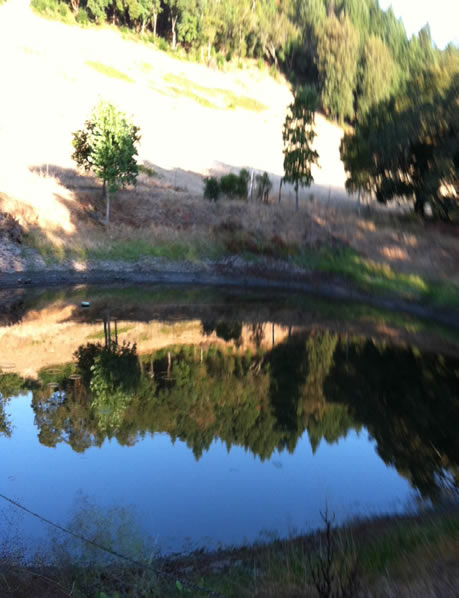
9/12/12 Brix Sampling today with Dr. Konrad. Latest numbers below.
| Block | Brix 8/30/12 |
Brix 9/12/12 | Brix 9/19/12 f |
Brix 9/21/12 | Brix 9/23/12 s | Brix 9/25/12 h |
Brix 10/1/12 k |
|---|---|---|---|---|---|---|---|
| K1 | 21.1 | 23.3 | 24.0 | 24.7 | |||
| K2U | 20.4 | 22.7 | 25.3 | 25.0,25.1 | 26.7 | ||
| K2L | 20.1 | 21.5 | 22.5 | 24.6 | |||
| K3U+K4U | 21.2 | 23.6 | 23.8 | ||||
| K3L | 20.4 | 22.4 | 26.7 | ||||
| K4L | 21.1 | 22.5 | 25.8 | ||||
| K5 | 20.3 | 22.1 | 22.6 | 23.5 | |||
| K6 | 19.3 | 21.4 | 22.0 | 23.6 | |||
| Malbec | 21.3 | 23.5 | 25.0 | ||||
| Average* | 20.6 | 22.4 |
* without Malbec, f = measured by Jeff Fontanella, s= measured by Lodi Labs for Sherman, Sherman sample crushed and cold soaked overnight before submission to lab. h= hunter k, konrad = k -- Note Konrad sampling sites are different from mholler's standard sites.
| Block | Brix 8/30/12 | Brix 9/7/12 F | Brix 9/12/12 | Brix 9/19/12 F | Brix 9/21/12 | Brix 9/26/12 F |
|---|---|---|---|---|---|---|
| C 1+2 | 18.3 | 20.6 | 20.1 | 21.8 | 21.2 | 22.4 |
| C4 Old Vines | 18.5 | 20.6 | 22.4 | 23.3 | ||
| C5 Upper | 18.1 | 20.0 | ||||
| C5 Lower | 18.9 | 21.2 | 22.1 | |||
| C7/C8 Swale | 19.9 | |||||
| C5 combined | 18.5 | 20.2 | 20.6 | 22.3 | 23.2 | |
| C8 - Wood | 17.1 | 19.9 | 20.2 | |||
| Merlot | 20.5 | 23.2 | 25.7 | |||
| Average* | 18.2 | 20.3 |
* without Merlot; F = sampled and measured by Franciscan
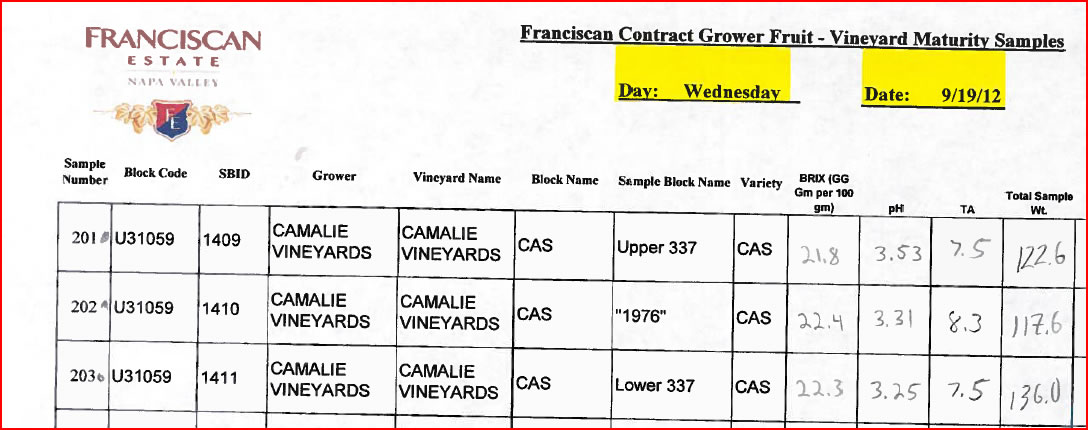
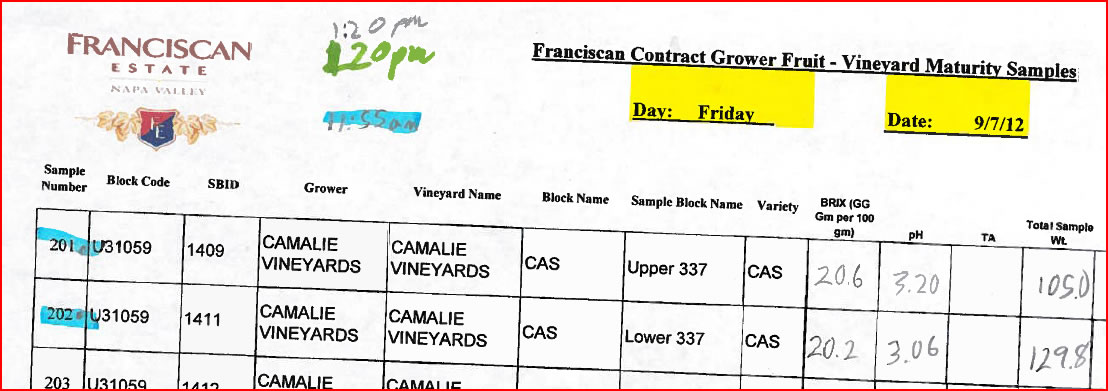
The 2.0 Brix higher values observed at Konrad Vineyards are the result of that vineyard having a warmer exposure. The degree days plot below shows the cumulative time between 50 and 95F for both vineyards over the last 5 weeks. You can see that Konrad Vineyards has 5% more degree days than Camalie over this period. The Brix difference is 10%, due to the nonlinear dependence of chemical reactions on temperature. They generally are exponentially dependent on temperature thus, a small difference in temperature can result in a larger difference in ripeness. The weather station at Konrad Vineyards on which this data is based is in K1. At Camalie in the middle of the vineyard. Which is better? In years like 2010 and 2011 where we had trouble ripening fruit, Konrad Vineyards' climate is definitely better. In a year like this where ripeness doesn't appear to be an issue the slower ripening at Camalie which is more representative of Mt. Veeder may be better.

8/31/12 Cleaned the irrigation filter at Konrad Vineyards for the first time all season. There was some evidence that water wasn't getting to the top of the upper blocks in the last week. The siphon feed continues to work flawlessly. We haven't had to reprime it all season. This is sustainable irrigation at its best.
8/30/12 First Brix Sampling of 2012 today. The left most column is the data from this year and the rest of the table is last year's data for reference. You can see we are a good 3 weeks ahead of last year I am so happy to say. Franciscan reported the same shift at their grower's breakfast last week.
The Malbec had the most and prettiest color. Flavors good but variable intensity of IBMP yet at this stage as you might expect.
| Block | Brix 8/30/12 |
Brix 9/4/11 | Brix 9/20/11 | Brix 9/22/10 | Brix 10/2/11 | Brix 10/7/11 | Brix 10/15/11 | T.A. g/l 10/15/11 |
pH 10/15/11 |
|---|---|---|---|---|---|---|---|---|---|
| K1 | 21.1 | 17.2 | 20.1 | 20.0 | 22.1 | 23.1 | |||
| K2U | 20.4 | 20.2 | 22.2 | 23.2 | |||||
| K2L | 20.1 | 19.1 | 18.3 | 19.6 | 19.3 | 20.8 | 7.75 | 3.48 | |
| K3U+K4U | 21.2 | 21.0 | 19.4 | 22.5 | 23.0 | 23.8 | 7.1 | 3.66 | |
| K3L | 20.4 | 19.8 | 19.5 | 21.4 | 21.6 | 22.2 | 7.9 | 3.65 | |
| K4L | 21.1 | ||||||||
| K5 | 20.3 | 20.6 | 19.6 | 22.5 | 23.4 | ||||
| K6 | 19.3 | 17.7 | 20.0 | 19.6 | 21.2 | 21.7 | 7.1 | 3.56 | |
| Malbec | 21.3 | ||||||||
| Average | 20.6 | 17.4 | 20.1 | 19.4 | 21.6 | 22.6 |
| Block | Brix 8/30/12 | Brix 9/4/11 | Brix 9/20/11 | Brix 9/22/10 | Brix Delta for 16 days | Brix 10/2/11 | Brix Delta for 12 days | Brix 10/15/11 | Brix Delta for 13 days | T.A. g/l 10/15/11 |
pH | Brix 10/23/11 | Brix 11/2/11 |
|---|---|---|---|---|---|---|---|---|---|---|---|---|---|
| C 1+2 | 18.3 | 18.9 | 16.6 | 20.4 | 1.5 | 21.1 | 0.7 | ||||||
| C4 Old Vines | 18.5 | 19.3 | 20.7 | 1.4 | 21.2 | 0.5 | 6.9 | 3.57 | 21.8 | ||||
| C5 Upper | 18.1 | 16.2 | 18.9 | 2.7 | 20.6 | 1.7 | 21.4 | 0.8 | 7.8 | 3.4 | 23.0 | ||
| C5 Lower | 18.9 | 19.8 | 21.6 | 1.8 | 22.4 | 0.8 | 3.42 | ||||||
| C7/C8 Swale | 20.0 | 20.5 | 0.5 | ||||||||||
| C5 combined | 18.5 | 19.3 | 18.2 | ||||||||||
| C8 - Wood | 17.1 | 19.1 | 19.4 | 20.1 | 1 | 21.3 | 1.2 | 7.35 | 3.55 | ||||
| Merlot | 20.5 | 21.9 | 22.2 | 23.9 | 2 | 24.4 | .5 | ||||||
| Average* | 19.2 | 18.0 | 2.7 | 20.5 | 1.6 | 21.3 | 0.75 |
Note: Samples taken mid morning 10:00am. Early morning to late afternoon delta is often one whole Brix.
Vine balance is perfect. Pictures from K5 below 8/30/12.
Here is the Pesticide Use report for Camalie Vineyards as of 8/29/12. No intent to spray going forward.
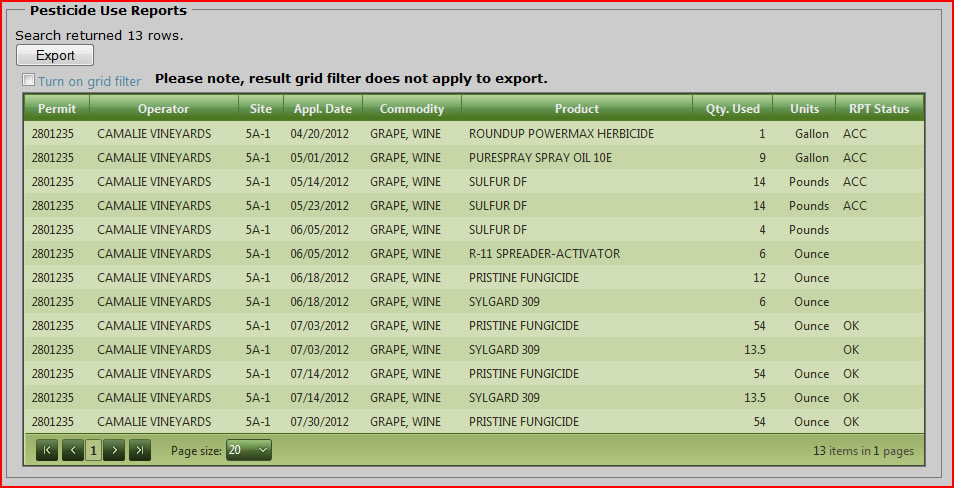
8/21/12 We are now 98% through veraison and Ramon is doing the "green drop". Janet Kapemeyer from Constellation shared their policy in writing which is essentially what we are doing. Here it is:
The shot below is from K3U.
I haven't started my Brix measurements yet but, some informal tasting of grapes I have done has been very encouraging. The IBMP is almost gone from the K1 fruit already. Sugars are coming up nicely and the acidity is good. They taste good in a general quality sort of way. This looks like one of the best years yet. Prepare to make great wine!
8/19/12 K1 now has a new owner, and I have a couple parties interested in K3L (.55 acre) . Below is a picture of K1 and its view. Mt. Diablo in the background.
The pond level is now 5' down and we have used about 221K gallons thus far this season which is about 27 gallons/vine or a little more for the vines that are getting water if you take into account about 25% of the vineyard is not getting any water. This is about 2/3 of our budget for the year. We used about 120K gallons in the last month and will likely use about that much more by the end of the season bring our total water use to about 45 gallons/vine. Looking at the soil moisture data I found that K3U was not receiving irrigation for the last two weeks. When I went out to the vineyard I discovered a hose had popped off of a submain one row over from the valve. It has been repaired and a couple remedial irrigations done.
8/14/12 Veraison is at 80-90% now. We had a nice spell of warm weather that rose gradually from 80 to a high of 98 on the 11th with 7 days of 90s We have been watching the irrigation closely. Notice the temp at Konrad Vineyards K1 is significantly warmer every night during this period which likely is helping with ripening in this block.

7/21/12 Hot day again today, about 95F at 3:30pm. Ramon reported seeing the first color change in K6 at Konrad vineyards. He thinks probably only one more spray for Powedery Mildew and he will be done. The PMI since last treatment is only up to 20 now.

I am watching the irrigation closely. I made a couple reductions in the irrigation times at Konrad last week for the cooler weather. The vigor in the lower part of K6 has been higher than usual this year and required some hedging. We shut off the irrigation to the lowest 11 rows.
7/8/12 I did some yield estimation at Camalie Vineyards at the request of my primary buyer. Below is the raw data and a summary.
iBlock 1-- 14, 21, 29 bunches going from East to West
iBlock 2 -- 23 , 39 bunches again East to West
iBlock 3 -- 25, 38 bunches ~Row 40 East to West,
iBlock 3 -- 30 bunches ~ row 50 top of ridge,
iBlock 3 -- 30 smaller bunches growth slowed.
iBlock 3 -- 23 smaller bunches row 55 fifteen vines from the East end.
iBlock 4 -- 34 larger bunches row 55 mid swale
iBlock 4 Merlot -- 29 bunches, mid row, second row downhill from forest.
Averaging all of these numbers except for the Merlot one gets 28 bunches per vine on average. Assuming 1/3 lb./bunch this translates to 9.3 lbs/vine. The total cab vine count for Camalie is 3900 vines which translates to a total yield of 18 tons if we do no selection or fruit drop. We typically drop on the order of 10% of the fruit near veraison to tighten up the ripeness distribution and bunch uniformity in general. This would leave us with 16.2 tons from 4.2 acres or 3.8 tons/acre. I think it is safe to say that if all goes well we will have one of our better yield years this year. Looking back at the vineyard's yield data from previous years you can see that this level of yield is not uncommon for Camalie vineyards. You can see that the vineyard produced similar yields in 2007 and 2009.
7/2/12 Ramon sprayed Camalie Vineyards with Pristine and Konrad Vineyards with wettable sulfur as part of the ongoing program to prevent Powdery Mildew. The Powdery Mildew Index has been high for over a week.

6/17/12 No sign of any wilting or burning of the vines. If anything growth was accelerated by the heat. I went out and took some photos just after sunrise in the morning cool. They contain some meaningful documentation of the state of the vines but, are more an expression of the beauty I see in the vineyards. They can be found at:
Camalie Vineyards Photos 6/17/12
Konrad Vineyards Photos 6/9/12
6/16/12 Its HOT-- 101F outside which gives me some time to sit down and update my blog. Having a 101 degree day after having nothing warmer than 90F the rest of the year is normally a formula for sunburn. We are about a week beyond bloom now. Ramon did a pass of shoot selection but, has not yet done leafing to expose fruit. He did do some North side leafing on 10 % of block 3 in the North East corner below the house at Camalie where mildew pressure is highest in the two vineyards. I am optimistic that we have dodged this sunburn bullet but, only time will tell. The weather is supposed to be 12 degrees cooler tomorrow and for the next week. We get 0-3 days of 100F weather on Mt. Veeder each year based on my 12 years worth of data.
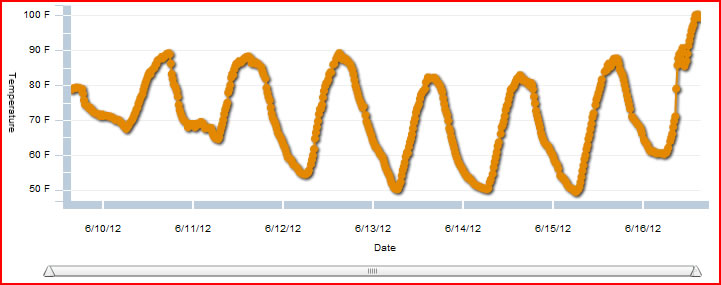
Over the last week I have been doing various maintenance on the nodes and sensors in my wireless networks. The Alpha net is now 5 years old and the rechargeable batteries are coming to the end of their lifespan and need to be replaced. The system software has also improved allowing me to look at more data in a shorter amount of time but it requires specification of what I want to see.
Here is a plot of the soil moistures at 24" depth at Konrad Vineyards. My goal with irrigation is to keep the soil moisture tension at the depth which is in the middle of the root zone between 100 and 150centibar. We have done a few irrigations at K1 and K4U as well as the Malbec and blocks C1 and C2 at Camalie but, the median vines can go a little longer. Vine vigor is good to high which means we want to give them some water stress to slow down the growth. Water stress between bloom and veraison is known to significantly improve fruit quality which is another reason likely related to reducing vigor. This is where the soil moisture tension sensing pays off. An average grower with a full reservoir and a 100F day is irrigating. Knowing what the soil moisture tension is we can hold back on our irrigation and achieve better fruit quality.
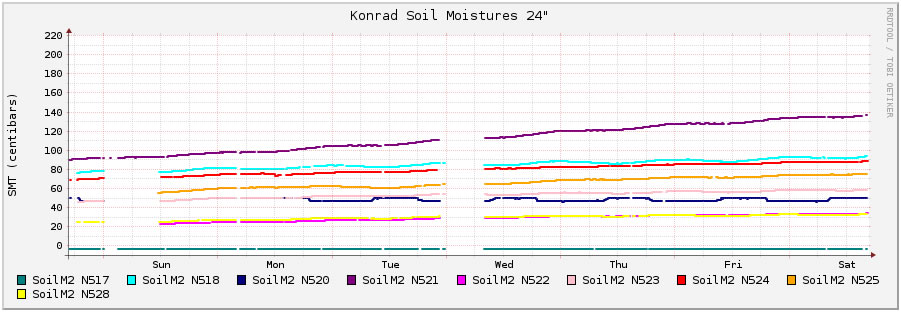
Below you can see a picture looking uphill in K1 showing the general level of vigor.
Below is a view looking uphill from mid K5 taken 6/9/12. In general I am very happy with the way the vineyard is looking.
Below is a plot of the Powdery Mildew Index at Camalie. It is has been high but, will drop another 10 points after todays heat. Ramon has applied wettable sulfur to both vineyards on 5/1-2, 5/10-12, 5/24 and 6/7. On 5/24 we applied Zinc and Boron in the spray as well to address slightly low levels and insure a good fruit set which we seem to have done.

6/9/12 Below you can see a representative picture of the fruit set from K5. Fruit set is very good. Notice also the sulfur on the young fruit protecting it from Powdery Mildew. Ramon has done 3 applications of sulfur thus far. Fortunately it has been a while since the last application unlike our neighbor who sprayed last night and may see some burning. With completion of bloom at Camalie we will switch to synthetic fungicide, Pristine as directed by our grape buyer there. At Konrad vineyards we will continue to use wettable sulfur to be as organic as possible.
Below you can see an example of some flowers that did not set fruit from the base of Camalie Block 3 on 6/17/12. The pistils actually turn black and fall off. Some of the small green berries will also fall off if you handle the cluster gently. It took me a while to find an example of this as most of the fruit set is quite good. At right below is a bunch of Merlot which is further ahead as always and yields very well.
5/23/12 Ramon is spraying wettable sulfur again today for Powdery Mildew. The index has been at its max for most of a week now. He has also made a pass of shoot selection in which his crew removes suckers and shoots that are not growing on last year's wood or are poorly positioned.
5/21/12 The petiole analyses for both vineyards came back today and is shown below. These samples were taken a week after we did our nitrogen fertigation and it looks like the vines took up the nitrogen immediately as all levels are elevated and a few in the excessive range. Block C3 lower is the lowest which has been the case for some years now which gives me confidence that this data is really from our vineyards.
Blocks K2L, K3L and K4L are relatively lower in nitrogen which has been our goal to reduce vigor in these blocks. They did not get fertigation again this Spring and it shows. K3U is lower but, should have received fertigation as usual this Spring. Had I seen this data earlier I would have skipped fertigating K6 this year and maybe given K3U, K4U a little more nitrogen.
Phosphorus levels are all elevated and Potassium levels are adequate to elevated which is why we have never put phosphorus or Potassium on the vineyards.
Trace minerals are all in line except for Boron and Zinc which are a little marginal which can impact fruit set. We applied both Boron and Zinc with the first wettable sulfur application on 5/15 a day after these samples were taken. This confirms that that application was appropriate.
DNA test results for two samples suspected of "measles" arrived CamalieDNAtestResults051412. Bottom line we have no measles, eutypa or virus in either sample except the Camalie Block 10 sample where we suspected the 191 scion material has leaf roll and indeed found Grapefine leaf roll 1 there. Fortunately the area of the vineyard with clone 191 is minimal and the effects are barely noticeable most of the time. None of the other 12 viruses tested for including fan leaf were found in either sample. It is really nice to have a definitive answer when so much of growing is "mysterious". The lack of any of the three measles fungi is very positive but, leaves us with no eplanation for the measles like symptoms we saw briefly early on. My best hypothesis in light of this data is that something associated with our first time spray for botrytis last season is to blame. We will think long and hard before doing that same application again this year.
Jason Valenti, our newest buyer -block K6 came out for a visit on Friday and walked the vineyard with Ramon. .
5/15/12 Ramon is spraying wettable sulfur today in defense against powdery mildew. He has added to the mix some Boron and Zinc to improve the fruit set at bloom which Ramon thinks will occur in the next 10 days to two weeks. The powdery mildew index reached maximum 100 but, has fallen back with the last two days of cooler weather.
5/14/12 Pictures from the vineyard
Block 1 at Camalie
Block K6
5/7/12 Fertigation was done. We applied 0-.8oz/vine doses of 15/0/0 Calcint (Calcium Nitrate) to the two vineyards. Details by block available. I don't have them handy at the moment. We have defined a petiole sampling plan and will get data sometime in the next month and adjust nutrition accordingly at that point.
In the spirit of transparency and full disclosure that I promised we have observed something that looks like black measles in the vineyards this spring. See the two photos below. The effect is visible on the lower 25% of the shoots with some of the earliest leaves affected. More recently the vines appear to be growing past it with the upper 3/4 of the shoots all clean and healthy.There is no visible impact on the flower primordia at this point. It is too early to tell if there will be impact on fruit yield or quality.
We have sent samples for DNA analysis at http://csplabs.com/index.php to see if the 3 black measles fungi are present on the vines. It is likely we will find them since they are generally found in all vineyards to one degree or another according to Doug Gubler at UC Davis. Here's an excerpt from an article on a recent talk he gave.
"The disease complex, by one name or another, has been described since antiquity and has evolved with vines. Plant pathologists have known for decades of the several fungi involved, although they could not introduce infections and cause symptoms and therefore discounted them as pathogens.
Only in the last several years has Gubler learned more about the pathogens’ biology, particularly that they grow rapidly in the presence of proteins in the sap of water-stressed vines. He was able to isolate them and then re-infect young, water-stressed vines with them.
At a recent plant disease seminar in Salinas, he identified the three major pathogens in California as Phaeomoniella chlamydospora, Phaeoacremonium inflatipes, and Phaeoacremonium aleophilium.
The first and second pathogens release spores from February to June, and the third from February to late July. All three reside in cavities on the vine, and fresh pruning wounds are highly susceptible to each for up to four months.
Gubler’s use of spore-trapping techniques and microscopic videos demonstrated that, once activated by rainfall or sprinkler irrigation, tiny structures of the pathogens can cast out spores at a distance of up to four inches. Water splashing and wind then carry the spores farther to invade new infection sites.
Typically, black measles infects vines 10 years or older, but it has been identified on the fruit and foliage of vines aged 2 to 4 years. Symptoms are often not visible until a year after infection, and severe symptoms have been linked to high summer temperatures."
An alternative hypothesis is that something in the late season sprays of phD and Serenade we put on for the first time last year for botrytis did something to cause these symptoms. If the DNA analysis comes back with no Black Measles fungi present this explanation rockets to the top of the list and we never use these materials again. The fact that the symptoms are not spreading from their initial positions on the shoots makes me lean toward this explanation. The pattern of the symptoms across the whole vineyard also suggest a spray related source. The DNA analysis is on samples from Camalie and includes tests for many other pathogens as well. The results are due back within the week. This is the first time we have taken advantage of this new bleeding edge testing capability. I expect some surprises in the data.
5/6/12 Photo below from Camalie Block 1
5/15/12 Welcome to my first blog of 2012. It's long overdue for which I apologize. Here's a little explanation of why its so late.
2011 was a tough year, yields half of normal, fruit marginally ripe, botyrytis and it cost me thousands of dollars for the experience. Before 2011 I thought I had grape growing under control, wireless soil moisture monitoring, controlled stress irrigation, nutrition, powdery mildew management..... 2011 was a humbling experience especially after 2010 which wasn't much better. The weather is the 800 lb. gorilla in the room and he's going to do whatever he pleases. I blew off my home wine making.
It has been tough for me personnally to get into growing grapes again this year. The question "Why bother?" comes to mind. If not for money, or pleasure then why? The answer is there is no logical answer. The best analogy I can think of is the question "Why have children?" There is no logical answer. There is at best a set of rationalizations people use when asked but, if you examine them closely they don't add up. Then why do so many people do these things? The best answer I can come up with is that these activities have been programmed into our DNA in the process of natural selection finding a way to propagate more humans on the planet. It's not hard to imagine how wine might contribute to more procreation.
With this in mind I do hearby surrender to my genes and abandon any further search for a logical reason to grow grapes. It's easier to run the program than try to find a reason to abort it. Let's get on with it!
I am consolidating what have been two separate blogs, one for Camalie Vineyards and another for Konrad Vineyards, into one blog. I will label vineyard specific content by putting the vineyard name after the date.
Camalie Grower's Blog 2010, 2011
Konrad Grower's Blog 2009, 2010
All photography by Mark Holler. Copyright 2012
Last Updated 9/21/12 M.Holler